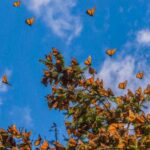North Carolina Group Caught on Camera Pulling Black Bear Cubs from Tree to Get Selfie
The post North Carolina Group Caught on Camera Pulling Black Bear Cubs from Tree to Get Selfie appeared first on Healthy Holistic Living.
In a disturbing incident captured on April 16, a group in North Carolina made headlines for all the wrong reasons. Outside an apartment complex in Buncombe County, individuals were caught red-handed, plucking bear cubs from a tree for a photo opportunity. The shocking scene, broadcasted by ABC11 partner WLOS, depicted the reckless act as they posed with the helpless cubs.
Ashley Hobbs, a special projects biologist with the North Carolina Wildlife Resources Commission, recounted the distressing aftermath. Responding to the distress call, Hobbs found a solitary cub left behind, damp and shivering. Though physically unharmed, the emotional toll was evident.
Rescue efforts swiftly ensued, ensuring the cub’s safety and well-being. However, the incident raised poignant questions about human-wildlife interaction. Hobbs, alongside conservationists like Jody Williams of Help Asheville Bears, condemned the actions as a stark display of ignorance and selfishness.
The Main Incident
North Carolina group caught while they were taking bear babies down from a tree to take photos with them. This event was recorded on April 16, and ABC11 partner WLOS showed it; the people stood outside an apartment complex in Buncombe County, took the small black bears out of the tree, and posed for a selfie holding one cub.
At the same time, the video showed a young bear going back to the fence. Ashley Hobbs, who is a special projects biologist with the North Carolina Wildlife Resources Commission, said they got a call when someone sent them this video on April 16. “An apartment complex in the Fairview area; that officer did ask me to assist him in response to that, so I did get on site, and I saw the cub,” Hobbs said. She mentioned that upon reaching the location, only a single cub remained.
Rescue and Recovery Efforts
It seemed wet and cold as if it had been by itself for quite some time. “Very traumatic to be pulled out of a tree like that,” Hobbs said. The young bear was said to not be hurt, but now they are looking after it at a place for recovery. “We did follow up with the people who pulled the bear out of the tree,” the biologist continued. “We did confront them on site that day. We let them know how irresponsible and potentially deadly it could be for that cub to be separated from its mom.”
She also said, “It is frustrating to see people be that irresponsible around wildlife because it is a blessing that we get to live in the mountains around these creatures.” Help Asheville Bears founder Jody Williams also expressed his disappointment. “All for a selfie, all for a selfie,” he said, adding, “It’s just ignorance, total selfishness. This is not what we talk about when we talk about coexisting.”
The event highlights how important it is to work fast on saving efforts for wildlife that can easily be harmed. Careless behavior puts single creatures at risk and also risks upsetting the careful harmony of natural environments.
Community Awareness
Raising awareness within communities about the importance of respecting wildlife and their habitats is paramount. Education and advocacy can help foster a culture of coexistence where humans and wildlife can thrive together harmoniously.
The swift response in rescuing the cub highlights the crucial role of wildlife rehabilitation facilities. These centers play a vital role in providing care and rehabilitation for injured or orphaned animals, giving them a chance to return to their natural habitat.
Incidents like these also raise questions about the adequacy of existing wildlife protection laws and the enforcement of such regulations. Holding individuals accountable for their actions serves as a deterrent and reinforces the message that wildlife exploitation will not be tolerated.
Promoting Ethical Tourism
Instances of wildlife exploitation for the sake of a photo op underscore the need for ethical tourism practices. Encouraging responsible tourism can help minimize the negative impact on wildlife and their habitats while supporting local conservation efforts.
Engaging local communities in wildlife conservation initiatives fosters a sense of stewardship and ownership over natural resources. By involving residents in conservation efforts, it empowers them to become champions for wildlife protection within their own communities.
While this particular incident was addressed promptly, it serves as a reminder that vigilance is key in safeguarding wildlife from human encroachment. Continued monitoring and reporting of suspicious activities can help prevent similar incidents from occurring in the future.
Celebrating Success Stories
Amidst the challenges, celebrating success stories of wildlife rescue and rehabilitation can inspire hope and encourage continued efforts in conservation. Highlighting positive outcomes serves as a beacon of progress in the ongoing battle to protect our planet’s precious biodiversity.
Building empathy and respect towards wildlife begins with education and instilling values of compassion and understanding from an early age. By nurturing a deep appreciation for the natural world, future generations can become advocates for wildlife conservation.
Collaboration between government agencies, non-profit organizations, and local communities is essential for effective wildlife conservation. By pooling resources, expertise, and knowledge, stakeholders can implement holistic approaches to address conservation challenges.
Long-Term Conservation Strategies
Developing and implementing long-term conservation strategies is crucial for ensuring the survival of endangered species and preserving biodiversity. These strategies should prioritize habitat protection, sustainable use of natural resources, and community engagement.
Wildlife conservation is a global responsibility that transcends borders and requires collective action. International cooperation and agreements are vital for addressing transboundary conservation issues and combating illegal wildlife trade.
Empowering citizens to contribute to scientific research through initiatives like wildlife monitoring programs enhances our understanding of ecosystems and species’ behavior. Citizen scientists play a valuable role in collecting data and informing conservation efforts.
Ethical Photography Guidelines
Establishing and promoting ethical photography guidelines can help prevent wildlife disturbance and exploitation. Educating photographers about responsible practices, such as maintaining a safe distance and minimizing disturbance, can mitigate the negative impact of wildlife photography.
Cultivating a culture of respect for wildlife involves recognizing the intrinsic value of every living creature and the interconnectedness of all species. By valuing biodiversity and acknowledging the rights of animals to live undisturbed in their natural habitats, we can foster a more harmonious relationship with the natural world.
Investing in conservation education programs equips individuals with the knowledge and skills to become stewards of the environment. By promoting environmental literacy and fostering a sense of environmental responsibility, we can inspire positive action and behavior change.
Strengthening Wildlife Protection Laws
Strengthening wildlife protection laws and enforcing strict penalties for wildlife-related offenses are essential steps in deterring illegal activities and ensuring the safety of vulnerable species. Robust legal frameworks provide a foundation for effective conservation efforts and uphold the rights of wildlife.
Engaging indigenous communities, who often have traditional knowledge and deep connections to local ecosystems, is critical for sustainable conservation initiatives. Collaborating with indigenous peoples fosters mutual respect and understanding while leveraging their expertise in conservation practices.
Promoting sustainable development practices that balance economic growth with environmental conservation is crucial for long-term wildlife protection. Implementing sustainable land-use planning, eco-tourism initiatives, and green infrastructure projects can minimize habitat destruction and mitigate human-wildlife conflicts.
Investment in Research and Technology
Investing in research and technology advancements, such as remote sensing and GPS tracking, enhances our ability to monitor wildlife populations and understand their behavior. Cutting-edge research tools provide valuable insights for conservation planning and adaptive management strategies.
Investing in green infrastructure, such as wildlife corridors and green spaces within urban areas, promotes habitat connectivity and allows wildlife to move freely across landscapes. By integrating nature into urban planning, we create healthier ecosystems and enhance biodiversity in our cities.
Supporting sustainable livelihoods for local communities that depend on natural resources encourages conservation stewardship. Alternative income-generating activities, such as eco-friendly agriculture and sustainable tourism, provide economic opportunities while minimizing environmental impact.
Empowering Women in Conservation
Empowering women in conservation leadership roles can lead to more inclusive and equitable decision-making processes. Recognizing and supporting the contributions of women in conservation strengthens community resilience and fosters innovative solutions to conservation challenges.
Promoting wildlife-friendly practices among industries, such as responsible waste management and sustainable forestry, reduces negative impacts on wildlife habitats. Encouraging businesses to adopt environmentally friendly practices contributes to wildlife conservation efforts on a larger scale.
Implementing community-based conservation initiatives empowers local residents to take an active role in protecting wildlife and their habitats. Engaging communities in conservation planning and management fosters a sense of ownership and ensures that conservation efforts align with local needs and priorities.
Youth Engagement and Education
Engaging youth in wildlife conservation through education and outreach programs instills a sense of environmental stewardship from an early age. Providing opportunities for young people to connect with nature and participate in conservation activities cultivates a lifelong commitment to protecting wildlife.
Promoting ecotourism initiatives that prioritize environmental sustainability and respect for wildlife supports conservation efforts while providing economic benefits to local communities. Responsible ecotourism practices offer opportunities for visitors to experience wildlife in their natural habitats while contributing to conservation financing.
Investing in wildlife rescue and rehabilitation centers ensures that injured or orphaned animals receive the care they need to recover and return to the wild. Supporting these facilities with resources and expertise strengthens our capacity to respond to wildlife emergencies and conserve threatened species.
Cultivating Partnerships with Zoos and Aquariums
Establishing partnerships with zoos and aquariums can facilitate wildlife conservation efforts through education, research, and captive breeding programs. These institutions play a vital role in raising awareness about conservation issues and supporting field conservation projects around the world.
Integrating traditional ecological knowledge into conservation practices enhances our understanding of local ecosystems and biodiversity. Collaborating with indigenous and traditional communities allows for the the incorporation of time-tested conservation methods and promotes cultural preservation.
Providing support and training for wildlife rehabilitation volunteers enables them to effectively care for injured or orphaned animals and contribute to conservation efforts. Recognizing the valuable contributions of volunteers encourages continued engagement and commitment to wildlife protection.
Advocacy for Policy Change
Advocating for policy change at local, national, and international levels can lead to stronger wildlife protection measures and stricter enforcement of existing regulations. Engaging policymakers and advocating for wildlife-friendly policies is essential for creating a legal framework that safeguards biodiversity and habitats.
Promoting sustainable fishing practices, such as selective harvesting and habitat protection, helps minimize the impact of fishing activities on marine and freshwater ecosystems. By encouraging responsible fishing practices, we can conserve fish populations and protect the biodiversity of aquatic environments.
Incorporating climate change resilience strategies into conservation planning helps wildlife adapt to changing environmental conditions. Implementing habitat restoration projects and establishing protected areas that are resilient to climate impacts ensures the long-term survival of vulnerable species.
Encouraging Corporate Responsibility
Encouraging corporate responsibility through sustainable sourcing policies and corporate conservation initiatives promotes environmentally friendly business practices. By holding corporations accountable for their environmental impact, we can reduce habitat destruction and support wildlife conservation efforts.
Empowering local conservation leaders and grassroots organizations strengthens conservation efforts at the community level. Providing training, resources, and support to local leaders fosters sustainable conservation practices and ensures that conservation initiatives are locally driven and culturally appropriate.
Investing in green technology and innovation promotes the development of eco-friendly solutions to conservation challenges. Technologies such as renewable energy, electric vehicles, and sustainable agriculture reduce reliance on fossil fuels and minimize habitat destruction, contributing to wildlife conservation efforts.
Inclusive Conservation Policies
Promoting inclusive conservation policies that consider the needs and perspectives of marginalized communities ensures that conservation efforts are equitable and socially just. Incorporating diverse voices into decision-making processes leads to more effective and sustainable conservation outcomes.
Promoting wildlife-friendly land management practices, such as agroforestry and organic farming, creates habitats that support biodiversity while maintaining agricultural productivity. By integrating conservation principles into land-use planning, we can conserve wildlife populations and promote sustainable food production.
Encouraging citizen science projects enables members of the public to contribute valuable data to conservation research efforts. Engaging citizens in monitoring wildlife populations, tracking migrations, and documenting habitat changes increases our understanding of ecosystems and informs conservation decision-making.
Investing in community-based ecological restoration projects empowers local communities to actively participate in restoring degraded habitats and recovering biodiversity. By involving communities in the restoration process, we not only improve ecosystem health but also foster a sense of pride and ownership over natural resources.
The post North Carolina Group Caught on Camera Pulling Black Bear Cubs from Tree to Get Selfie appeared first on Healthy Holistic Living.











